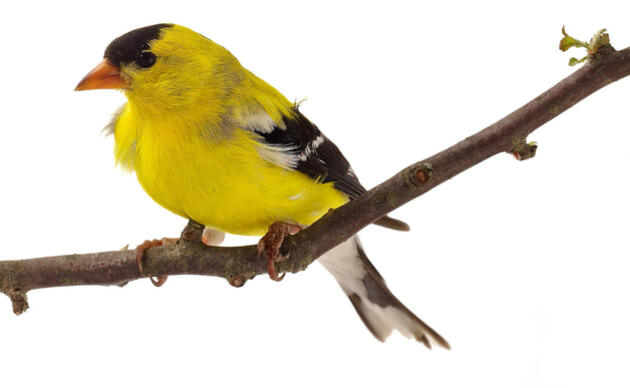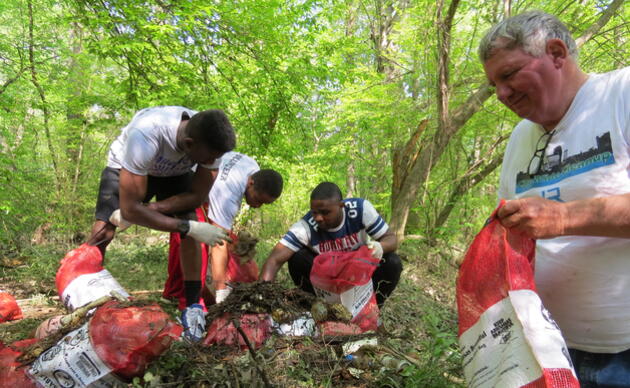By Mark Schleifstein, The Times-Picayune. Originally published by the Times-Picayune.
Only two tiny strips of sand and shell, dotted with a few skeletal remains of mangrove trees, are all that was left of Cat Island, a tiny isle in Barataria Bay that held thriving colonies of brown pelicans, wading birds and gulls prior to the BP Deepwater Horizion oil spill, on Tuesday (Mar. 31).
Heavily oiled during the 2010 spill -- several photo shoots of oiled and dead pelicans in April and May of that year featured wildlife found on the island -- the combined hit of oiled plant life and ongoing subsidence and erosion have all but eliminated the sandy spit as a haven for wildlife.
On Tuesday, only a single pair of American oystercatchers, their red beaks used to pry open oysters, were on either of the remaining islets, possibly guarding a lone nest in the sand.
Tuesday's trip across Barataria Bay from Myrtle Grove Marina to East Grand Terre Island was sponsored by Restore the Mississippi River Delta Coalition, which includes representatives of the Environmental Defense Fund, the National Audubon Society, National Wildlife Federation, Coalition to Restore Coastal Louisiana, Lake Pontchartrain Basin Foundation and Restore or Retreat.
The coalition was formed several years before the spill, aimed at supporting state and federal efforts to rebuild wetlands and barrier islands in the delta area in Louisiana. After the spill, the organization has also focused on insuring the best use of fine money and federal Natural Resource Damage Assessment money for Louisiana restoration projects.
On Tuesday, the environmental groups wanted to show reporters from New Orleans, Baton Rouge, Houma and Houston what they contend are signs that the effects of the millions of gallons of oil released into the Gulf of Mexico during the spill can still be seen five years later.
The trip comes two weeks after BP issued its own report on the status of the Gulf environment five years after the spill. In its report, BP argued that the Gulf and coastal shoreline environments have already rebounded from the effects of the spill, and pointed out that only a few locations like East Grand Terre are still being actively cleaned.
On Monday, the National Wildlife Federation issued its own report that raised concerns about 20 Gulf species.
About a mile north of Cat Island, another tiny island seems to have captured the interest of dozens of nesting pelicans and other sea birds, possibly including some that moved on after Cat Island became untenable as a rookery.
Doug Meffert, vice president of the National Audubon Society, said the damage to Cat Island is indicative of the spill's threat to a variety of protected bird species that spend a critical part of their life cycles along the Gulf Coast.
"We need to protect the habitat that we have that's critical for birds, and we need to restore and recreate new habitat for birds and other species because we are losing that habitat," he said. "We are seeing losses (associated with the oil spill) at twice the rates that might normally occur."
Meffert said it will be important for Audubon and other environmental groups to demand that as some of the major restoration projects envisioned by federal and state officials are completed, they be assessed to assure success in providing essential habitat for birds.
"We need long-term stewardship and monitoring," he said.
Farther south, a trek across the beach along the eastern end of East Grand Terre Island showed that the most recent effort by BP contractors to remove weathered oil washing ashore after being unearthed by erosion and waves left some asphalt-like oil mat and numerous pebble-sized balls of squishy tar and sand behind.
Discovered during a joint BP-state targeted monitoring system, the workers reportedly removed more than 27,000 pounds of mat and tar ball. But some large chunks of sand and tar remain on the beach. Some pebble-shaped tar balls left oily stains on the skin when squeezed.
Just offshore, pelicans perch on a sand spit, while a pair of dolphins accompanied by a baby dolphin swam nearby.
"A month or so after the oil spill began, in April 2010, we started to see oil washing up on our beaches and into our marshes," said Alisha Renfro, a staff scientist with the National Wildlife Foundation for the delta campaign, who holds a doctorate in marine and atmospheric sciences.
"What happened to a lot of that oil is it sank down into the sand and just underneath the surfaces of the beaches, or was deposited just offshore and created these submerged mats," she said, holding up a piece of the asphalt-like material.
Even after five years, storms and waves are unearthing the oil remains, and it ends up on beaches, she said, sometimes triggering responses like the one on East Grand Terre in recent days.
"Where we are now is that 'chasing the dog' scenario," she said. "You find oil, you run out and clean it up. We need to still do the cleanup when we see it, but we also need to do restoration.
"What we saw during the oil spill were dramatic images of birds that were actively oiled," Renfro said. "These tar mats, submerged mats and tar balls as they wash up don't seem like they should be that dangerous, but what it points to is a chronic re-oiling of the environments, what the turtles use, that the birds use."
The result, she said, is continued exposure that could lead to more long-lasting effects, different from the acute effects caused by animals being covered by oil.
"What this points to is we're going to have to continue to look at this for a long time," Renfro said. "We're going to have to continue to track these animals and see what is happening with them over time."





